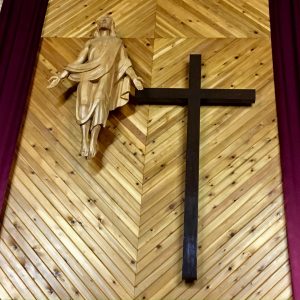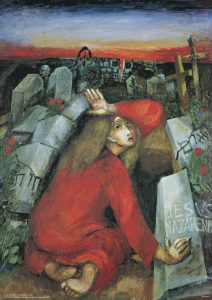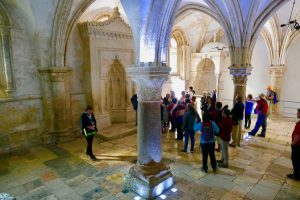HOMILY EASTER SUNDAY – C
Experience Easter through Forgiveness and Healing
(Acts 10:34, 36-43; Col 3:1-4; Jn 20:1-18)
**********************************************
 Four dominant symbols draw our attention over the Easter season: The Cross, the Empty Tomb, the Garden and the Upper Room. These symbols are metaphors that help us experience the new life of Easter through forgiveness and healing.
Four dominant symbols draw our attention over the Easter season: The Cross, the Empty Tomb, the Garden and the Upper Room. These symbols are metaphors that help us experience the new life of Easter through forgiveness and healing.
The Cross first of all leads us to experience God’s love as forgiveness. In the first reading we hear that Jesus is the Messiah, the anointed one, who died and is risen. He will judge the living and the dead. We receive forgiveness through his name. On the Cross, Jesus forgave us all our sins. We need only receive that forgiveness now through genuine repentance, confession, absolution and penance. Easter is all about receiving forgiveness for our sins.
 The Empty Tomb leads us into our need for healing. The stone was removed and the disciples went right into the tomb. There they found the linen wrappings left behind. The empty tomb and the linen cloth represent our need for healing. Our reaction to hurt is usually anger, resentment and hatred instead of forgiveness. That is not sin but sinfulness, that which makes us sin, and for that we need healing. The linen cloth that stayed in the tomb symbolizes our sinfulness that needs to stay there. We must go into our own personal tombs, identify our defects, pray about them, and receive healing from them
The Empty Tomb leads us into our need for healing. The stone was removed and the disciples went right into the tomb. There they found the linen wrappings left behind. The empty tomb and the linen cloth represent our need for healing. Our reaction to hurt is usually anger, resentment and hatred instead of forgiveness. That is not sin but sinfulness, that which makes us sin, and for that we need healing. The linen cloth that stayed in the tomb symbolizes our sinfulness that needs to stay there. We must go into our own personal tombs, identify our defects, pray about them, and receive healing from them

Jesus appears to Mary Magdalene, by the late Fr. Seiger Köder
The Garden scene teaches us how to grieve and mourn our losses. Mary was told not to cling to Jesus. She could not have him back the way he was before. He had changed. There was more – the Holy Spirit – he wanted to share with her and the others. But first she had to learn to grieve, to let go of him. Every time we are hurt, we experience some loss. We also need to go into the Garden, identify our losses, grieve them and let go of sadness, self-pity and depression. Mary Magdalene became the first evangelist through a process of grieving and letting go.
Finally, the Upper Room empowers us to forgive. There was only peace and joy, and no trace of bitterness, after Jesus had been betrayed, denied, abandoned, brutally tortured and murdered. Jesus forgave his abusers and empowered the disciples to forgive. He sends them, and us, out on a mission to live this new life of forgiveness

The Cenacle or Upper Room in Jerusalem
St. Paul sums it all up in the second reading when he claims that we have died with Christ and have been raised up with Christ. We must let go of earthly things and need seek only heavenly things now.
It is worth noting that the 12 Step Program of Alcoholics Anonymous reflect these four symbols of Easter. Steps 4 & 5, 8 & 9 are all about the Cross – receiving forgiveness from God, ourselves, one other person and finally all those whom we have hurt.
Steps 6 & 7 are all about the Empty Tomb, the Garden and the Upper Room, in that we name our defects of character like anger and grief, pray about them and open ourselves to receive healing from them. God replaces these defects with peace and joy as we forgive those who hurt us and accept our losses.
The Eucharist we celebrate this morning makes present for us the forgiveness, love, and the acceptance of Christ that led to his resurrection that Easter morning.
May our celebration today strengthen our faith, lead us to forgive our hurts, accept our losses, and experience Easter in our lives right here and right now.




Happy Easter since the Lord is resurrected and free us sins so we can experience his forgiveness and unconditional love . We are to be blessed and rejoice that he has given us everything that we have been hoping for. So, let us let go of the anger, false prides, bitterness, stubbornness and resentments. All the negative thoughts that tempt us to sins; we must learn to go through reconciliation by confessing our sins and ask God to forgive our sins. We are willing to repent and change our ways of behavior to treat people with respect and dignity. We are to treat God the same way and put him the Centre of our lives like praise and worshipping him. It is to show people that he already is risen and see the the place way they laid him. Lastly, we are to go out to spread the Good News to people and to communities that Jesus is resurrected . Jesus is present within us when we receive the Communion or the Eucharist. He is alive! Rejoice ! Alleluia!
Thanks for the homilies and reflections about Easter and the risen Lord. Happy Easter! Bishop Sylvain Lavoie. Take care and many Blessings!